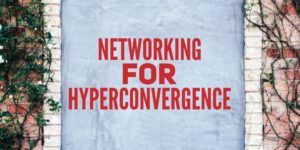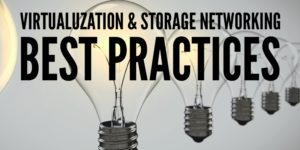The
SNIA Networking Storage Forum (NSF) kicked off the New Year with a live webcast “
Virtualization and Storage Networking Best Practices.” We guessed it would be popular and boy, were we right! Nearly 1,000 people registered to attend. If you missed out, it’s available
on-demand. You can also download a copy of the
webcast slides.
Our experts, Jason Massae from VMware and Cody Hosterman from Pure Storage, did a great job sharing insights and lessons learned on best practices on configuration, troubleshooting and optimization. Here’s the blog we promised at the live event with answers to all the questions we received.
Q. What is a fan-in ratio?
A. fan-in ratio (sometimes also called an “oversubscription ratio”) refers to the number of hosts links related to the links to a storage device. Using a very simple example can help understand the principle:
Say you have a Fibre Channel network (the actual speed or protocol does not matter for our purposes here). You have 60 hosts, each with a 4GFC link, going through a series of switches, connected to a storage device, just like in the diagram below:
 Read More
Read More
 In the last few years, Ethernet equipment vendors have announced big increases in line speeds, shipping 25, 50, and 100 Gigabits-per -second (Gb/s) speeds and announcing 200/400 Gb/s. At the same time Fibre Channel vendors have launched 32GFC, 64GFC and 128GFC technology while InfiniBand has reached 200Gb/s (called HDR) speed.
But who exactly is asking for these faster new networking speeds, and how will they use them? Are there servers, storage, and applications that can make good use of them? How are these new speeds achieved? Are new types of signaling, cables and transceivers required? How will changes in PCIe standards and bandwidth keep up? And do the faster speeds come with different distance limitations? Read More
In the last few years, Ethernet equipment vendors have announced big increases in line speeds, shipping 25, 50, and 100 Gigabits-per -second (Gb/s) speeds and announcing 200/400 Gb/s. At the same time Fibre Channel vendors have launched 32GFC, 64GFC and 128GFC technology while InfiniBand has reached 200Gb/s (called HDR) speed.
But who exactly is asking for these faster new networking speeds, and how will they use them? Are there servers, storage, and applications that can make good use of them? How are these new speeds achieved? Are new types of signaling, cables and transceivers required? How will changes in PCIe standards and bandwidth keep up? And do the faster speeds come with different distance limitations? Read More
 In the last few years, Ethernet equipment vendors have announced big increases in line speeds, shipping 25, 50, and 100 Gigabits-per -second (Gb/s) speeds and announcing 200/400 Gb/s. At the same time Fibre Channel vendors have launched 32GFC, 64GFC and 128GFC technology while InfiniBand has reached 200Gb/s (called HDR) speed.
But who exactly is asking for these faster new networking speeds, and how will they use them? Are there servers, storage, and applications that can make good use of them? How are these new speeds achieved? Are new types of signaling, cables and transceivers required? How will changes in PCIe standards and bandwidth keep up? And do the faster speeds come with different distance limitations? Read More
In the last few years, Ethernet equipment vendors have announced big increases in line speeds, shipping 25, 50, and 100 Gigabits-per -second (Gb/s) speeds and announcing 200/400 Gb/s. At the same time Fibre Channel vendors have launched 32GFC, 64GFC and 128GFC technology while InfiniBand has reached 200Gb/s (called HDR) speed.
But who exactly is asking for these faster new networking speeds, and how will they use them? Are there servers, storage, and applications that can make good use of them? How are these new speeds achieved? Are new types of signaling, cables and transceivers required? How will changes in PCIe standards and bandwidth keep up? And do the faster speeds come with different distance limitations? Read More
 Many followers (dare we say fans?) of the SNIA Networking Storage Forum (NSF) are familiar with our popular webcast series “
Many followers (dare we say fans?) of the SNIA Networking Storage Forum (NSF) are familiar with our popular webcast series “ Hyperconverged infrastructures (also known as “HCI”) are designed to be easy to set up and manage. All you need to do is add networking. In practice, the “add networking” part has been more difficult than most anticipated. That’s why the SNIA Networking Storage Forum (NSF) hosted a live webcast “
Hyperconverged infrastructures (also known as “HCI”) are designed to be easy to set up and manage. All you need to do is add networking. In practice, the “add networking” part has been more difficult than most anticipated. That’s why the SNIA Networking Storage Forum (NSF) hosted a live webcast “
 In the storage world, NVMe
In the storage world, NVMe is arguably the hottest thing going right now. Go to any storage conference – either vendor-related or vendor-neutral, and you’ll see NVMe as the latest and greatest innovation. It stands to reason, then, that when you want to run NVMe over a network, you must understand NVMe over Fabrics (NVMe-oF). Meanwhile, TCP is by far the most popular networking transport protocol both for storage and non-storage traffic.
TCP – the long-standing mainstay of networking – is the newest transport technology to be approved by the
is arguably the hottest thing going right now. Go to any storage conference – either vendor-related or vendor-neutral, and you’ll see NVMe as the latest and greatest innovation. It stands to reason, then, that when you want to run NVMe over a network, you must understand NVMe over Fabrics (NVMe-oF). Meanwhile, TCP is by far the most popular networking transport protocol both for storage and non-storage traffic.
TCP – the long-standing mainstay of networking – is the newest transport technology to be approved by the  Unlike traditional local or scale-up storage, scale-out storage imposes different and more intense workloads on the network. That’s why the SNIA Networking Storage Forum (NSF) hosted a live webcast “
Unlike traditional local or scale-up storage, scale-out storage imposes different and more intense workloads on the network. That’s why the SNIA Networking Storage Forum (NSF) hosted a live webcast “ Ever make a mistake configuring a storage array or wonder if you’re maximizing the value of your virtualized environment? With all the different storage arrays and connectivity protocols available today, knowing best practices can help improve operational efficiency and ensure resilient operations. That’s why the SNIA Networking Storage Forum is kicking off 2019 with a live webcast “
Ever make a mistake configuring a storage array or wonder if you’re maximizing the value of your virtualized environment? With all the different storage arrays and connectivity protocols available today, knowing best practices can help improve operational efficiency and ensure resilient operations. That’s why the SNIA Networking Storage Forum is kicking off 2019 with a live webcast “